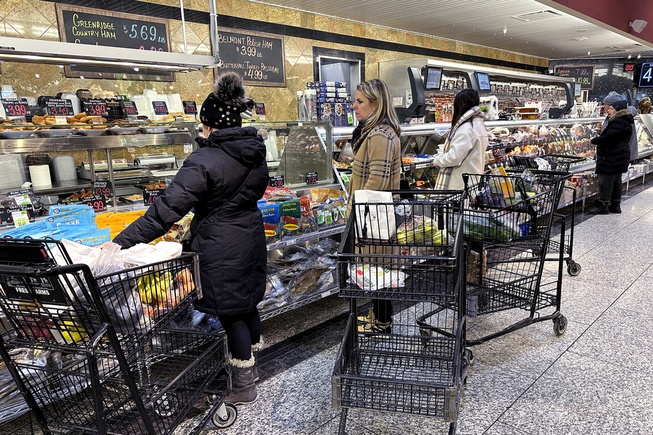
Nam Y. Huh / AP
Customers wait for orders at a grocery store in Wheeling, Ill., Friday, Jan. 19, 2024.
Friday, Jan. 26, 2024 | 8:55 a.m.
WASHINGTON — The Federal Reserve’s preferred inflation gauge cooled further last month even as the economy kept growing briskly, a trend sure to be welcomed at the White House as President Joe Biden seeks re-election in a race that could pivot on his economic stewardship.
Friday’s government report showed that prices rose just 0.2% from November to December, a pace consistent with pre-pandemic levels and barely above the Fed's 2% annual target. Measured from a year earlier, prices increased 2.6%.
Excluding volatile food and energy costs, so-called “core” prices rose just 0.2% from month to month and 2.9% from a year earlier — the smallest such rise since March 2021. Economists consider core prices a better gauge of the likely path of inflation.
The latest data suggests that the economy is achieving an elusive“ soft landing,” in which inflation falls back to the Fed’s target without a recession. That outcome could make it easier for the Fed to consider cutting its key interest rate, which it raised 11 times since March 2022 to attack inflation. Higher interest rates have throttled home sales by raising the cost of borrowing. Businesses have also chafed under the higher borrowing costs.
On Thursday, a government report showed that the economy expanded at a surprisingly strong 3.3% annual pace in the final three months of last year. Solid consumer spending propelled the growth, capping a year that had begun with widespread expectations of a recession but instead produced a healthy expansion.
Biden’s Republican critics have sought to highlight what had been the biggest inflation spike in four decades, for which they have largely blamed the president’s spending policies. But with inflation having dropped sharply after an extended period of gloomy consumer sentiment, Americans are starting to show signs of feeling better about the economy. A measure of consumer confidence by the University of Michigan, for example, has jumped in the past two months by the most since 1991.
The details in Friday's report all point to inflation being in check: Measured over the past six months, prices are up just 1.9%, which is actually below the Fed's 2% target. Over the past three months, the figure is even lower: 1.5%.
Grocery prices, after nearly two years of sharp increases, were unchanged in December and were just 1.3% higher than a year earlier. Chicken prices actually dipped 0.4% from November to December; they're up 1.2% compared to a year ago. Beef and veal prices, though, climbed 0.3% in December and are still 8.7% higher than 12 months earlier.
The report arrives less than week before the Fed will hold its latest policy meeting. The central bank is considered sure to keep interest rates unchanged, but attention will be focused on Chair Jerome Powell's news conference for any clues about when the Fed might begin to cut rates.
“The Fed will be welcoming the inflation data," said Lydia Boussour, senior economist at consulting firm EY. "It does suggest that inflation is on track and the Fed is well-positioned to start (cutting rates) in a few months.”
During 2023, inflation fell steadily as global supply chains recovered from pandemic-era disruptions and more Americans came off the sidelines to take jobs, which helped slow wage growth. Slower-rising pay eases the pressure on businesses to raise prices to offset higher labor costs. According to the Fed’s preferred measure, inflation peaked at 7.1% in June 2022.
More Americans now appear to be pushing back against the price spikes of the past two years. In response, there are signs that some companies are forgoing price hikes or implementing smaller increases.
The Fed's most recent beige book report, a collection of anecdotes mostly from businesses around the country, found many examples of companies finding that they now have less ability to raise prices.
That trend appears particularly evident at auto dealerships. Car dealers now have many more vehicles on their lots than in the depths of the pandemic, when factory shutdowns left consumers desperate to find a new or used car. David Kelleher, for example, who owns a Chrysler-Jeep dealership just outside Philadelphia, said his profit margins have plunged 70% since 2021 now that consumers have more options and can haggle again.
Kelleher is offering enhanced discounts to try to attract buyers.
“There’s less appetite to absorb the higher cost," he said.
In the aftermath of the pandemic, Kelleher said, he might have had five Jeep Wranglers on his lot and 25 customers who wanted one, giving him significant pricing power. Now, he has 78 Wranglers, and many of his competitors are well-stocked as well.
“That's good for the consumer," who can play the dealers off each other, Kelleher conceded.
In December, the Fed’s policymakers had projected that they would carry out three quarter-point rate cuts this year. Yet they provided little hint of when the first cut might occur. Late last year, Wall Street traders had bet that the first rate cut would occur in March.
Several Fed officials, though, have pushed back against such assumptions. Christopher Waller, an influential figure on the Fed’s Board of Governors, last week reiterated his view that inflation is on track to return to the Fed’s 2% goal. But Waller cautioned that any decision to cut rates should be “carefully calibrated and not rushed” — remarks that were widely interpreted as downgrading the likelihood of a March cut.
Friday’s price data showed a lower level of inflation than did the most recent consumer price index, released earlier this month, which showed inflation at 3.4% in December. The more widely known CPI shows higher inflation than the Fed’s preferred measure partly because it puts greater weight on housing and rents, whose prices are higher than for many other goods and services.
